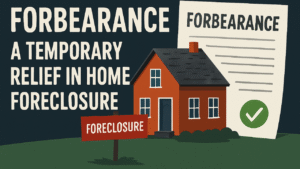 Forbearance: A Temporary Relief in Home Foreclosure
Forbearance: A Temporary Relief in Home Foreclosure
Forbearance is a financial arrangement between a homeowner and their lender that provides temporary relief from mortgage payments during times of financial hardship. It is a valuable tool for borrowers facing foreclosure, offering a chance to stabilize their finances and avoid losing their home.
What Is Forbearance?
Forbearance refers to an agreement in which the lender allows the borrower to reduce or suspend mortgage payments for a specified period. This arrangement is typically granted when the borrower is experiencing temporary financial difficulties, such as job loss, medical expenses, or other unforeseen circumstances. During the forbearance period, the lender agrees not to initiate foreclosure proceedings, giving the borrower time to recover.
Why Does Forbearance Happen?
It occurs when a borrower is unable to meet their mortgage obligations but demonstrates a willingness to work with the lender to resolve the situation. Lenders often prefer forbearance over foreclosure because it helps maintain the borrower-lender relationship and avoids the costs and complexities associated with foreclosure. Forbearance is particularly beneficial for borrowers who expect their financial situation to improve in the near future.
How Does Forbearance Work?
The forbearance process typically involves the following steps:
- Contacting the Lender: The borrower must reach out to their lender to explain their financial hardship and request forbearance.
- Submitting Documentation: The lender may require proof of hardship, such as income statements, medical bills, or unemployment records.
- Negotiating Terms: The lender and borrower agree on the duration of the forbearance period, payment adjustments, and repayment terms.
- Signing an Agreement: A formal forbearance agreement is signed, outlining the terms and conditions.
Options for Borrowers
During the forbearance period, borrowers have several options to manage their mortgage:
- Resume Payments: Once the forbearance period ends, borrowers must resume regular payments and repay the deferred amounts.
- Repayment Plan: Borrowers can work with the lender to create a repayment plan that spreads the deferred payments over a set period.
- Loan Modification: In some cases, lenders may agree to modify the loan terms to make payments more manageable.
- Refinancing: Borrowers may explore refinancing options to secure a lower interest rate or extend the loan term.
What Happens Next?
At the end of the forbearance period, borrowers must fulfill the terms of the agreement to avoid foreclosure. Failure to comply with the repayment plan or resume payments may result in the lender initiating foreclosure proceedings. It is crucial for borrowers to communicate with their lender and explore all available options to ensure a smooth transition.
Potential Outcomes
Forbearance offers several benefits for borrowers:
- Avoiding Foreclosure: It provides temporary relief and prevents foreclosure during financial hardship.
- Preserving Credit: While forbearance may impact credit scores, it is less damaging than foreclosure.
- Time to Recover: Borrowers gain valuable time to stabilize their finances and explore long-term solutions.
In conclusion, forbearance is a lifeline for homeowners facing foreclosure, offering temporary relief and a chance to regain financial stability. By understanding the process and working closely with their lender, borrowers can navigate this challenging situation and protect their home.